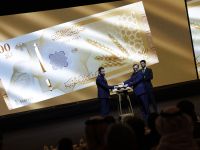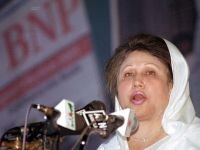One of the most challenging terrains in the seismic industry today is the transition zone between water and land. CGG has developed new techniques and designed new equipment to cope with the extreme demands of these zones and meet rigorous client requirements to respect the environment, and conduct surveys with zero impact.
Their effectiveness was demonstrated by two successful surveys conducted recently in the US and on the Caspian Sea.
3D survey for Shell in the United States:
Towards the end of 1996, a CGG crew equipped with the very latest acquisition technology undertook a four-month 3D survey for Shell-US in the paddy-fields and swamps of South Louisiana.
The survey covered approximately 78sq.m (200 km2) and was located on a very old oilfield, which has been in production for over 60 years, on Cajun territory.
The Cajun community, who are of French origin, have a unique culture, which is especially renowned for its music and cuisine, and a very strong sense of identity.
These cultural considerations only added to the natural difficulties. Water was omnipresent and could have potentially hindered crew progress.
Quads were therefore used to a considerable extent to help the crew move about while equipment was transported by helicopter.
In the swamps, we decided to use airboats, which are propelled above the water with an airplane engine. Although extremely practical, these flat-bottomed boats had the drawback of making the killer bees in the area go crazy with the vibrations made by their propeller blades.
Apart from some pretty birds (ashen herons, kingfishers, buzzards and grey geese), a significant proportion of the local fauna are rather dangerous, with a high population of alligators (who fortunately prefer eating dogs to men) and aggressive snakes (including the extremely fearsome water mocassin cottonmouth).
Even workers who were used to working in the desert of Southern Texas sometimes decided against continuing the adventure with us.
The survey's location on an old oilfield meant that the safety of operations was compromised by the presence of abandoned and unmarked wellheads and pipelines which could still conceal hydrocarbons.
All the shot point sites in the northern part of the prospect, where the problem was most acute, therefore had to be checked with a metal detector within a 10 m radius.
Permitting started several months before the surveying crew started work. Numerous restrictions, either total or partial, immediately cropped up. The large number of partial restrictions were often of an environmental nature.
The region is a winter refuge for millions of migrating birds, ducks and geese mainly, and also a traditional haunt for hunters of all kinds, either locals or weekend trippers from the four corners of the United States.
We were therefore often restricted to working on the pieces of land in question between 10 h and 14 h on Fridays, Saturdays and Sundays. If a watch were to stop or a surveying error were made, it would be sanctioned by a few rifle shots (in the air).
In other spots, operations had to be scheduled between the last rice harvest of the year and the time when the field is flooded for repopulating with crayfish. In the northwestern part of the prospect, we even had to clean all our machines before working there, to avoid contaminating the land with the neighbour's rice.
If the restrictions were total i.e. in "No-Permit areas", we were simply prohibited from working on a particular piece of land and forced to do a considerable amount of work repositioning sources and receivers with CGG's Geoland software, in order to maintain coverage acceptable to the client.
With the combination of Geoland and a Sercel SN 388 recording unit capable of recording 2400 traces, the crew was able to win its bet by finishing the work for the end of the year, with production peaking at over 400 shots per day.
Initial results showed the data to be of excellent quality, even at a depth of several seconds, which bodes well for processing a target shown to be at 19,000ft.
Although the American market is highly competitive, CGG is committed to guaranteeing the quality of seismic data it delivers and accommodating client requirements.
On the Shell survey, CGG took care to adapt to working practices in the United States and work in close co-operation with the client.
With a highly professional crew boasting equipment adapted to local conditions, it succeeded in supplying error-free data, while respecting the environment and treating safety as an on-going priority.
Transition zone seismic on the Caspian Sea:
CGG was contracted by the Oryx Kazakhstan Energy Company to acquire seismic data in the Mertvyi Kultuk prospect located on the East coast of the Caspian sea, 6 hours drive North from the nearest town, Aktau, in the Republic of Kazakhstan.
The survey area had large expanses of open water up to 3 m deep, separated by many low-lying islands, and extended on to the shore in some parts. The elevation changes were very gradual, resulting in large mud flats between the water and sea.
The planned starting date was only 4 months after the contract award, leaving very little time to plan a complex shallow water/transition zone crew and then mobilize the required personnel and equipment in association with our location partners, the Turlan Geophysical Expedition and the Mangystau Geophysical Expedition.
On complex transition zone crews such as this, where much of the activity depends on the constantly changing terrain, water levels and weather conditions, effective planning and communications are vital to best use crew resources as priorities constantly change and to effectively communicate with all personnel, as this has important safety implications.
The hardest riddle to solve was that of the water depth which could be affected by local changes in wind direction, wind speed or atmospheric pressure. A movement of 1 m in water level in 24 hours was not uncommon and the most extreme example was a drop of 1.3 m overnight.
Two daily weather forecasts were used to ascertain the next day's general weather pattern. Much more unpredictable were the micro effects of the complicated pattern of islands and channels. The water could be rising at one point and falling 1 kilometer away!
Each night a "game plan" would be constructed for the next day and then copied and distributed to all personnel. An important part was the effective allocation of resources.
But these resources were not fixed: for example, the Balco drill rigs which are low foot print and can be reconfigured to drill in a variety of methods such as auger, hammer, flush or conventional rotary.
They could be changed depending on the terrain faced by the drillers. They were mounted on boats (for deep water), sledges (pulled through mud), march buggies (driven through shallow water), or small tracked vehicles (land work).
For in-field quality control and processing, all support data was produced in SPS files. This included positioning data recorded by the Differential Global Positioning System, the type of receivers for each position, which were a mix of bottom cable with hydrophones and marshphone-cased geophones, and the recording geometry, etc.
The data tapes from the recorder were transferred onto the field processing workstation and their overall quality was checked. The shot point first breaks were used to QC the positioning data.
A full processing flow including residual statics, DMO and migration was performed on site with a normal turnaround time of 3 days from the last shot on a line to the shipping date.
The in-field processing was an integral and critical part of the acquisition sequence. A high-speed satellite data link on the crew connected it with the client in Dallas, Texas. On completion, the processed stacks were transmitted to the client by satellite for provisional interpretation.
On the strength of this interpretation, the client would modify the recording programme. In this way, the whole acquisition process became interactive, giving the client greater control.
This meant that he was able to cancel lines that were no longer interesting, and focus on areas of greatest potential. Thus saving considerable time and money.
The right choice of crews and equipment, in full co-operation with local partners, led to the successful completion of this very complex survey within the deadline and confirmed CGG's know-how and experience in difficult regions.
Source:WWW.CGG .COM
by Samuel Herculin and Colin Fairgrieve, Land Seismic Party Managers
© 2000 Mena Report (www.menareport.com)







